14 March 2024
Emilie Paquet, Head of Strategic Initiatives and Innovation, Multi-Asset Solutions Team
Vladyslav Kyrychenko, Senior Investment Analyst, Multi-Asset Solutions Team
Generating lifelong retirement income is a challenge—and one that’s not shared equally between men and women. With longer average life spans, women are often more at risk of not meeting their retirement income targets. We measure the extent to which a longer lifespan affects factors that are crucial to women’s retirement readiness.
Women face unique challenges compared to men when planning for income in retirement. One factor that no-one has control over is how long we will live. Women often face average life spans longer than men, which puts them at higher potential risk of not reaching their target for income in retirement. Additionally, women face the challenge of potentially taking a career break to have children and are typically more likely than men to give up full time employment to care for family members. These disruptions may often increase shortfall risk, which is exacerbated by women’s longer average life spans.
In the context of retirement, shortfall risk is the danger of not meeting your income replacement rate, which is the percentage of your income prior to retirement that you want as a monthly or yearly income during retirement. The industry standard for planning purposes is to use a 70% replacement rate. In other words, 70% of your monthly income prior to retirement is the amount of income you want every month during retirement. Achieving this goal is not easy. Yet by understanding the extent to which four primary factors affect shortfall risk, women may be better-informed when making long-term decisions:
We used the following assumptions as a base case against which to measure the effect these various factors will have:
All other things being equal, our analysis shows that longevity risk in retirement is such that a woman in Asia retiring at age 65 will consistently have a higher shortfall risk than a man due to longer average life expectancy. In Hong Kong, a woman at retirement has 28% shortfall risk; In other words, as a woman, you will have a 28% probability of not meeting your income replacement target. This is concerning given that it’s based on 40-years of uninterrupted accumulation and a 10% total contribution rate. What if you have a career break to start a family or stop working to care for elderly parents? Any of these circumstances have the potential to increase shortfall risk.
Due to longer life expectancies, women have a greater risk of income shortfall in retirement
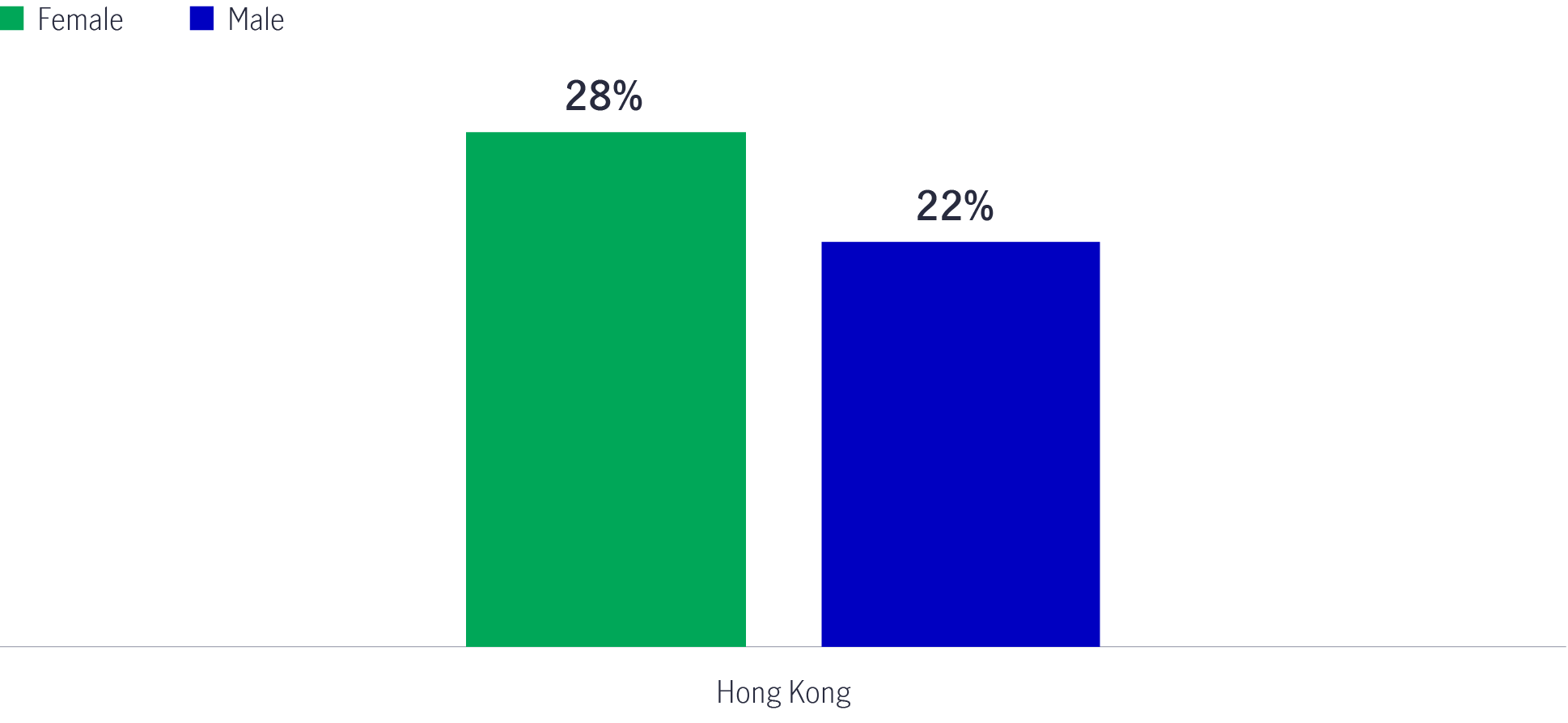
Source: Multi-Asset Solutions Team, Manulife Investment Management, December 2023.
When you start accumulating investments for retirement has a significant effect on whether you reach your income replacement target and, therefore, affects your retirement savings shortfall. In aiming to quantify this risk, we analyzed varying outcomes based on different starting ages: 25, 35 and 45.
If you start retirement contributions at age 35, instead of 25, our analysis shows that your shortfall risk is 38%, which is a high number. Starting 10 years later than that—age 45—pushes your shortfall risk up to 52% if you’re living in Hong Kong, which is significant.
Effects on shortfall risk when delaying investing for retirement

Source: Multi-Asset Solutions Team, Manulife Investment Management, December 2023.
Importantly, this risk remains high even if you ultimately set aside the same total contributions. This is because the early benefits of compounding cannot be caught up later. Consider the following hypothetical scenario:
Mei and Lu both contribute the same amount to their retirement investment—HKD 720,000—and receive the same annual growth rate of 5%. However, Mei delays her start date by 10 years. Although both women’s contributions are the same, Mei’s delayed start means she doesn’t benefit from the early compounding that gives Lu over HKD 600,000 more by retirement.
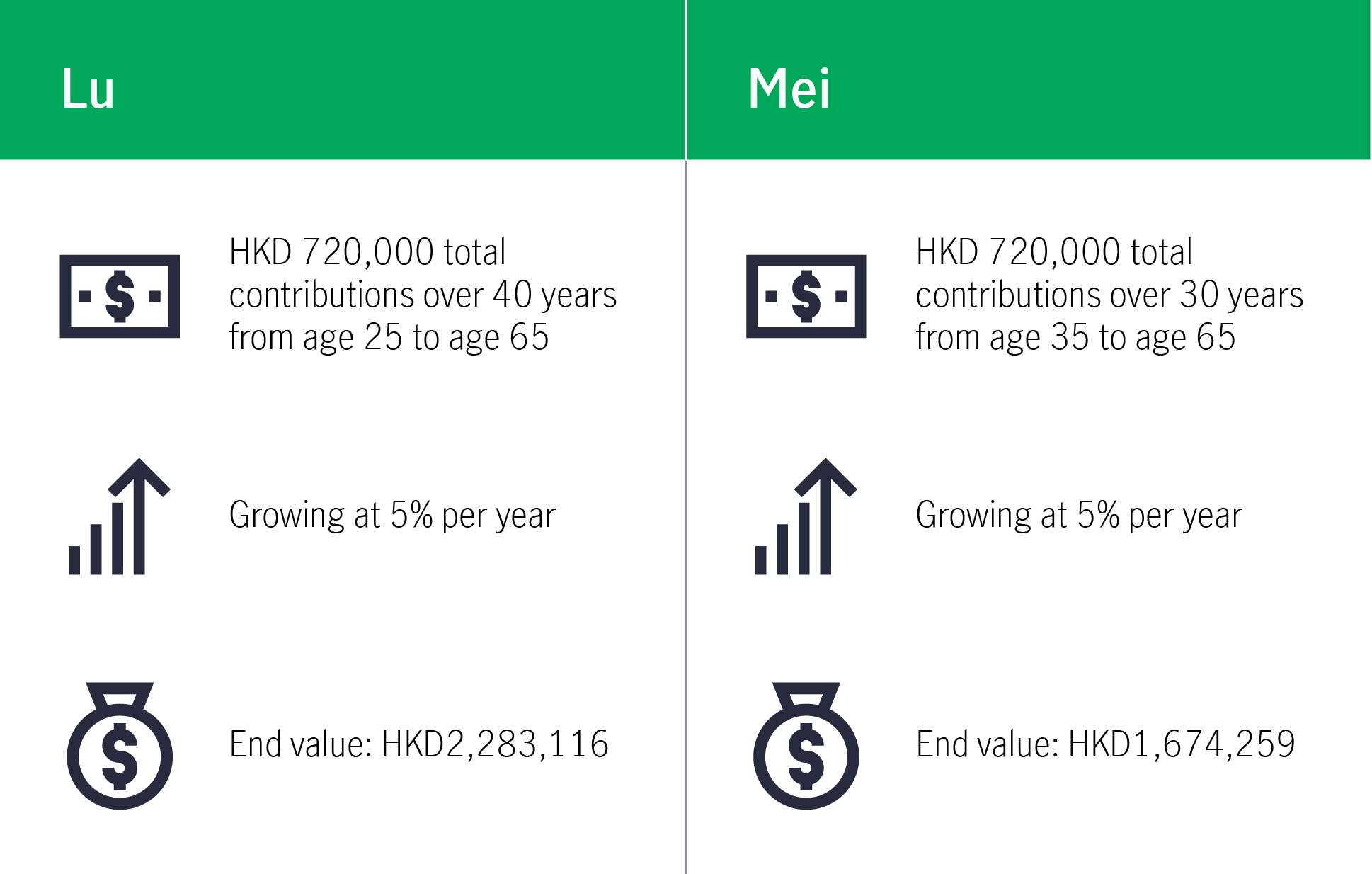
Lu’s total accumulation is 36% higher than Mei’s.
Measuring the effects of early compounding
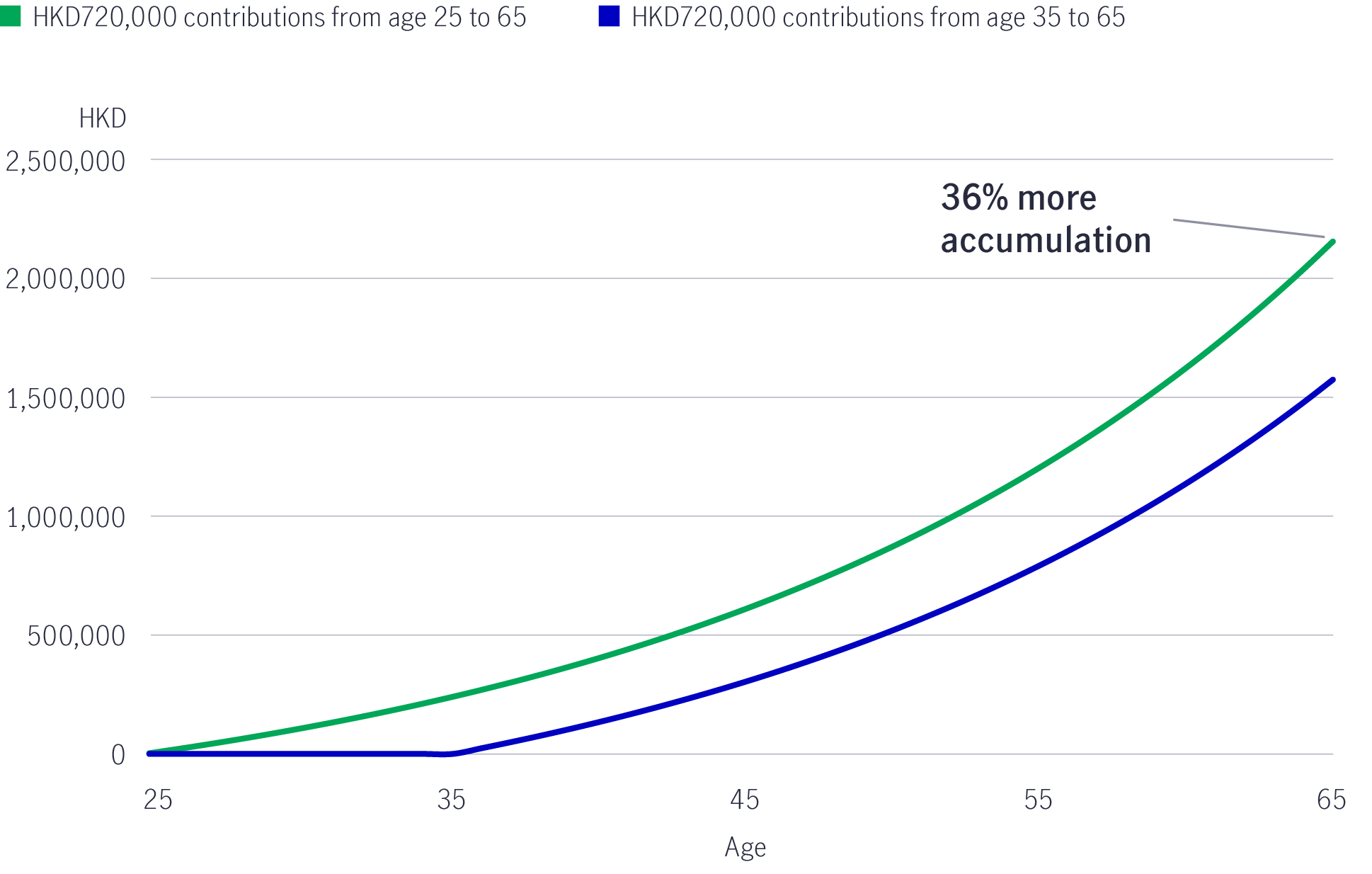
Source: Multi-Asset Solutions Team, Manulife Investment Management, 13 November, 2023. The above illustration does not depict an investment in any Manulife Investment Management portfolio and is a hypothetical example for comparison purposes only. Rates are subject to change. This illustration does not reflect the effect of asset charges and account fees. These fees would reduce the performance shown in the above illustration. The investment return and principal value of an investment may fluctuate so that distributed investments may be worth more or less than their original value. The illustration assumes: (1) no initial lump sum, HKD18,000 invested yearly for 40 years; (2) no initial lump sum, HKD24,000 invested yearly for 30 years. (3) no withdrawals. All hypothetical assumptions include a compound annual growth rate of 5%, accrued yearly. There are no guarantees that the results shown will be achieved.
Unsurprisingly, how much you save has a significant effect on your income for retirement. However, when we measure the results of saving 5% more—or less—than the 10% base case, the positive and negative effects are unevenly distributed. For example, saving half of the 10% base rate may more than double your shortfall risk from 28% to 68%.
However, to potentially cut your risk in half doesn’t require you to double your contributions. Increasing total contributions from 10% to 15% has the potential to limit your shortfall risk significantly.
Shortfall risk based on different contribution rates
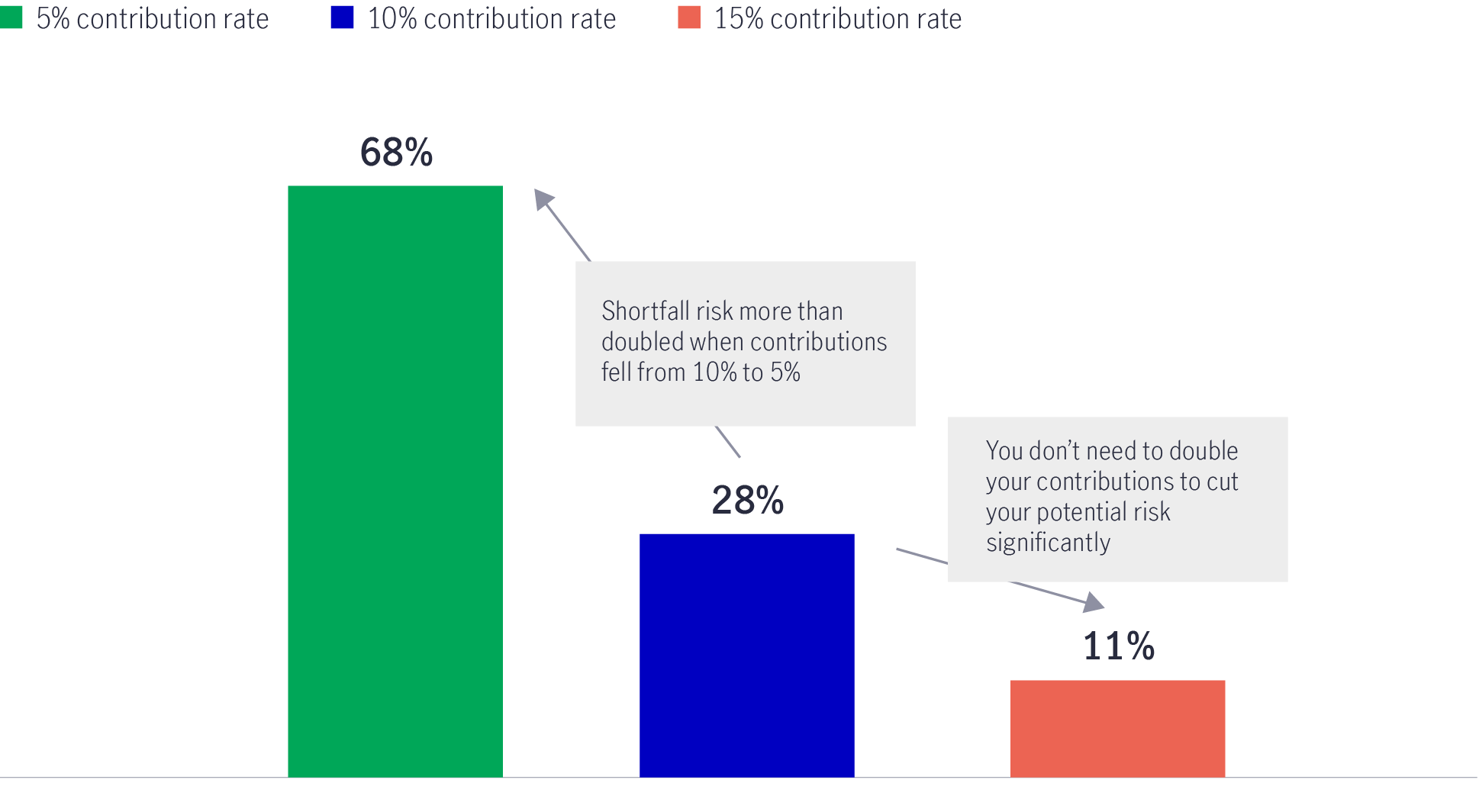
Source: Multi-Asset Solutions Team, Manulife Investment Management, 13 November, 2023.
We often refer to retirement savings, but a more accurate description is retirement investments. Savings generally suggests putting money aside for a future purpose, but this underemphasizes a critical choice, which is choosing how to optimally help grow your money for the future—in other words, investing.
Investing for retirement requires careful consideration of the options available to help your money grow without taking on unnecessary risk. However, in the context of a long lifespan, the inability to capture sufficient growth is an important and significant risk. In our analysis, we looked at shortfall risk in the context of investment choice. Our analysis shows that undiversified, conservative options such as cash or near-cash investments, increases shortfall risk to as high as 84%, even higher if you start accumulating your investments later than 25 years old and/or have a total contribution rate less than 10%. Choosing your retirement investments carefully is important, which is why financial advice may be helpful and where options aimed at long-term retirement investing, such as a target-date strategy that changes the asset allocation mix throughout your accumulation journey, may be beneficial. Speak to a financial professional to get long-term financial planning advice.
Diversifying your investment choices helps to lower shortfall risk
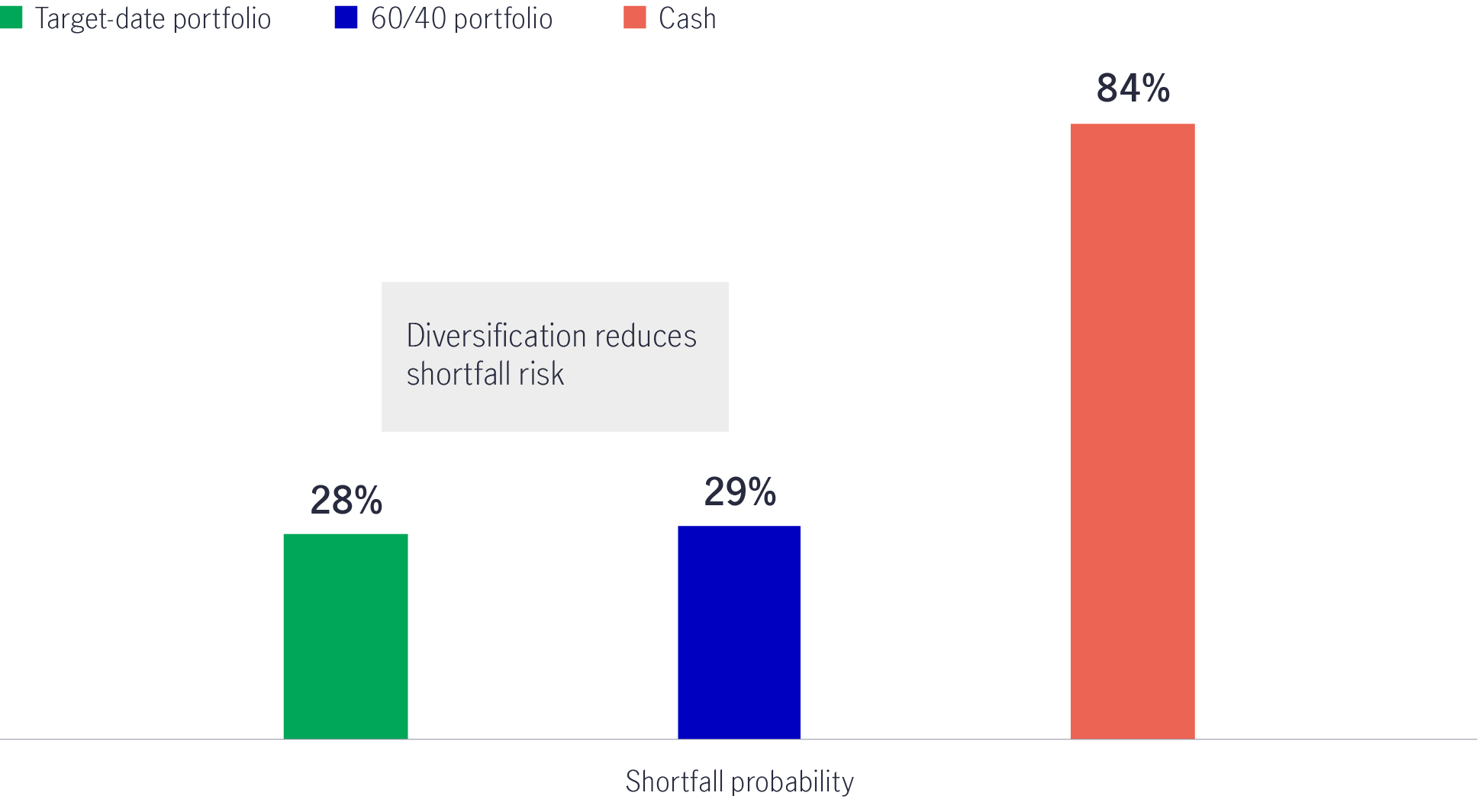
Source: Multi-Asset Solutions Team, Manulife Investment Management, 13 November, 2023. Above portfolios are based on indexes. Please see important disclosures below for a list of indexes used and the composition of the 3 hypothetical portfolios. It is not possible to invest directly in an index. Past performance does not guarantee future results.
Women face unique challenges compared to men when planning for income in retirement, especially in relation to the one factor that no-one has control over—how long we’ll live. As such, it’s important to be informed about what affects shortfall risk. Time horizon and how much you allocate towards your total retirement contributions will have the largest affect on meeting your income target. But making prudent investment choices are just as critical to ensure your money is working as hard as you need it to be, especially in the context of a longer life. Investing for retirement is challenging, but it’s not insurmountable. Being knowledgeable about the risks you may face as a women and working with a financial professional to devise a plan based on personal goals and circumstances is the approach you should consider to help make better financial decisions for the future.
Important disclosures about portfolio compositions
Data is based on Manulife Investment Management's Multi-Asset Solutions Team (MAST) asset class forecasts, which comprise MAST's expectations of how different asset classes will perform in the future over a 20-year-plus time horizon. Refer below to the list of indexes used. It is not possible to invest directly in an index. Past performance does not guarantee future results. Forecasts are derived using quantitative modeling techniques, which are mathematical and statistical based methods—some of which are widely used in financial markets and some of which are developed specifically by MAST—for analyzing complex financial data. In addition, forecasts include estimates of anticipated economic conditions, including, but not limited to, inflation and interest rates, GDP and currency exchange rates, and the anticipated effects these may have on financial markets and asset prices. There is no assurance that such events will occur, and actual asset class returns may be significantly different from those shown here. This material should not be viewed as a recommendation or a solicitation of an offer to buy or sell any investment products or to adopt any investment strategy and are not meant as predictions for any particular index, mutual fund, or investment vehicle.
Target-date portfolio at age 25 consists of equities (95%), cash (1%), fixed income (4%); at age 65 consists of equities (50%), fixed income (45%), cash (5%). 60/40 portfolio consists of equities (60%) and fixed income (40%), cash portfolio consists of cash (100%).
Within equities, there are five single/regional market equities in both the target-date portfolio and 60/40 portfolio: Hong Kong equities, North American equities, European equities, Japan equities, Asia Pacific (ex Japan and Hong Kong) equities. They do not carry equal weights, those weights change over the course of the glidepath.
Hong Kong equities are represented by the FTSE MPF Hong Kong Index; North American equities are represented by the FTSE MPF North America Index; European equities are represented by the FTSE MPF Europe Index; Japan equities are represented by the FTSE MPF Japan Index; Asia Pacific (ex Japan and Hong Kong) equities are represented by the FTSE MPF Asia Pacific ex Japan & Hong Kong Index.
Within fixed income, there are three types of bond in both the target-date portfolio and 60/40 portfolio: Global core investment grade, Asia local bonds and Hong Kong bonds. They do not carry equal weights, those weights change over the course of the glidepath.
Global core investment grade bonds are represented by the Bloomberg U.S. Aggregate Bond Index. Asia local bonds are represented by the Markit iBoxx Asian Local Bond Index. Hong Kong bonds are represented by the Markit iBoxx ALBI Hong Kong Index.
Cash is represented by the Mandatory Provident Fund Schemes Authority (MPFA) Prescribed Savings Rate, at which interest is for the time being payable in respect of a Hong Kong dollar savings account with deposit amount of HKD 120,000.
Plan for retirement with inflation in mind
To live comfortably in sliver age, your goal should not be merely to accumulate assets worth a nominal value. Inflation should also be considered to ensure an investment appreciates over the years, so its real purchasing power can satisfy your retirement needs.
A comprehensive retirement income strategy
To achieve a generous income and hassle-free post-retirement life, it is crucial to develop a comprehensive strategy that includes maintaining moderate investments and receiving a potentially regular and stable income.
Make good use of lower-risk funds to navigate market volatility
After a brief ‘risk off’ period, investors should consider a timely reallocation of their assets from Conservative Fund and Guaranteed Fund to other fund options that align with their risk tolerance levels.
Plan for retirement with inflation in mind
To live comfortably in sliver age, your goal should not be merely to accumulate assets worth a nominal value. Inflation should also be considered to ensure an investment appreciates over the years, so its real purchasing power can satisfy your retirement needs.
A comprehensive retirement income strategy
To achieve a generous income and hassle-free post-retirement life, it is crucial to develop a comprehensive strategy that includes maintaining moderate investments and receiving a potentially regular and stable income.
Make good use of lower-risk funds to navigate market volatility
After a brief ‘risk off’ period, investors should consider a timely reallocation of their assets from Conservative Fund and Guaranteed Fund to other fund options that align with their risk tolerance levels.